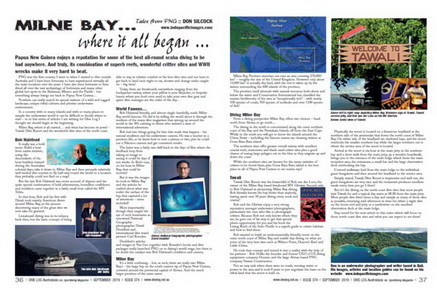Milne Bay – where it all began… Papua New Guinea enjoys a reputation for some of the best all-round scuba diving to be had anywhere. And truly, its combination of superb reefs, wonderful critter sites and WWII wrecks make it very hard to beat.
PNG was the first country I went to when I started to dive outside Australia. And I have been fortunate to have experienced virtually all the main locations over the years.
I have also been fortunate to have dived all over the vast archipelago of Indonesia. And many other global hot-spots in the Bahamas, Mexico and the Pacific. But something always brings me back to Papua New Guinea…
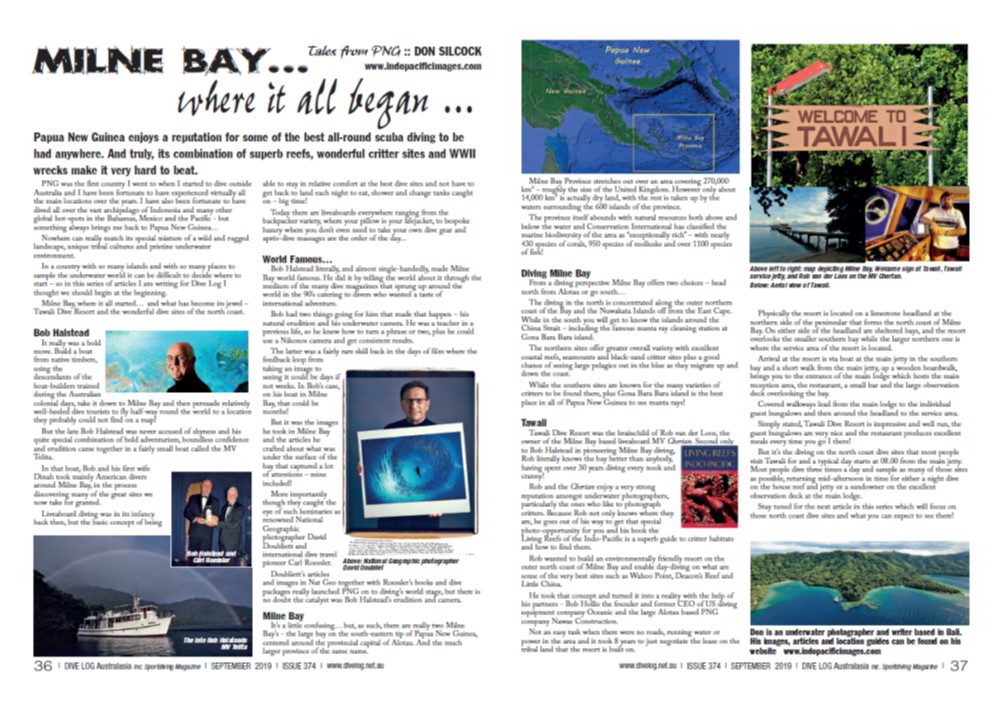
Nowhere can really match its special mixture of a wild and rugged landscape, unique tribal cultures and pristine underwater environment.
In a country with so many islands and with so many places to sample the underwater world it can be difficult to decide where to start. So in this series of articles I am writing for Dive Log I thought we should begin at the beginning.
Milne Bay, where it all started and what has become its jewel… Tawali Dive Resort and the wonderful dive sites of the north coast.
Bob Halstead
It really was a bold move build a boat from native timbers. Using the descendants of the boat-builders trained during the Australian colonial days. Take it down to Milne Bay and then persuade relatively well-heeled dive tourists to fly half-way round the world to a location they probably could not find on a map!
But the late Bob Halstead was never accused of shyness. And his quite special combination of bold adventurism, boundless confidence and erudition came together in a fairly small boat called the MV Telita.
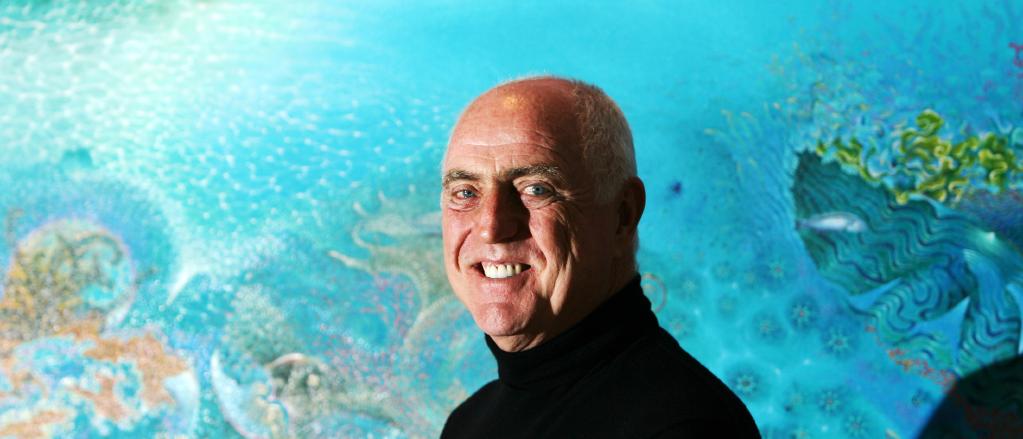
In that boat, Bob and his first wife Dinah took mainly American divers around Milne Bay. In the process discovering many of the great sites we now take for granted.
Liveaboard diving was in its infancy back then. But the basic concept of being able to stay in relative comfort at the best dive sites and not have to get back to land each night to eat, shower and change tanks caught on – big time!
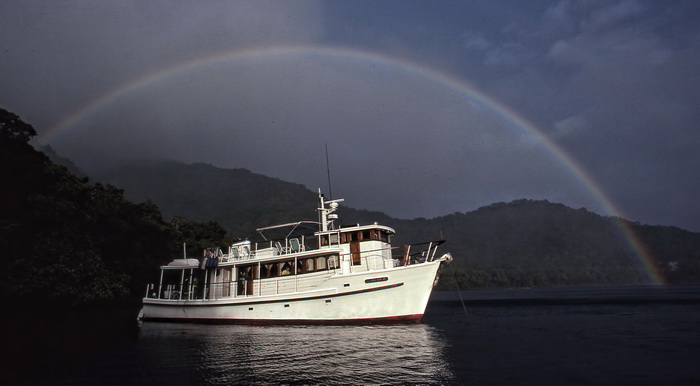
Today there are liveaboards everywhere ranging from the backpacker variety, where your pillow is your lifejacket. To bespoke luxury where you don’t even need to take your own dive gear and après-dive massages are the order of the day…
World Famous…
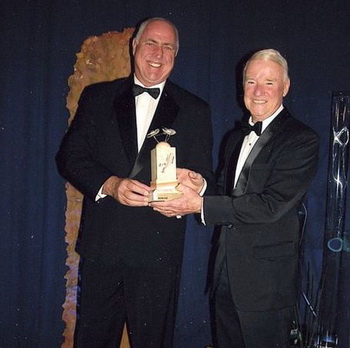
Bob Halstead literally, and almost single-handedly, made Milne Bay world famous. He did it by telling the world about it through the medium of the many dive magazines that sprung up around the world in the 90’s catering to divers who wanted a taste of international adventure.
Bob had two things going for him that made that happen. His natural erudition and his underwater camera.
He was a teacher in a previous life, so he knew how to turn a phrase or two. Plus he could use a Nikonos camera and get consistent results.

The latter was a fairly rare skill back in the days of film. Where the feedback loop from taking an image to seeing it could be days if not weeks. In Bob’s case, on his boat in Milne Bay, that could be months!
But it was the images he took in Milne Bay and the articles he crafted about what was under the surface of the bay that captured a lot of attentions – mine included!
More importantly though they caught the eye of such luminaries as renowned National Geographic photographer David Doubliett and international dive travel pioneer Carl Roessler.
Doubliett’s articles and images in Nat Geo together with Roessler’s books and dive packages really launched PNG on to diving’s world stage, but there is no doubt the catalyst was Bob Halstead’s erudition and camera.
Milne Bay
It’s a little confusing… but, as such, there are really two Milne Bays. The large bay on the south-eastern tip of Papua New Guinea, centered around the provincial capital of Alotau. And the much larger province of the same name.
Milne Bay Province stretches out over an area covering 270,000 km² – roughly the size of the United Kingdom. However only about 14,000 km² is actually dry land. With the rest is taken up by the waters surrounding the 600 islands of the province.
The province itself abounds with natural resources both above and below the water. And Conservation International has classified the marine biodiversity of the area as “exceptionally rich”. With nearly 430 species of corals, 950 species of mollusks and over 1100 species of fish!

Diving Milne Bay
From a diving perspective Milne Bay offers two choices – head north from Alotau or go south…
The diving in the north is concentrated along the outer northern coast of the Bay and the Nuwakata Islands off from the East Cape. While in the south you will get to know the islands around the China Strait. Including the famous manta ray cleaning station at Gona Bara Bara island.
The northern sites offer greater overall variety with excellent coastal reefs, seamounts and black-sand critter sites. Plus a good chance of seeing large pelagics out in the blue as they migrate up and down the coast.
While the southern sites are known for the many varieties of critters to be found there. And Gona Bara Bara island is the best place in all of Papua New Guinea to see manta rays!
Tawali
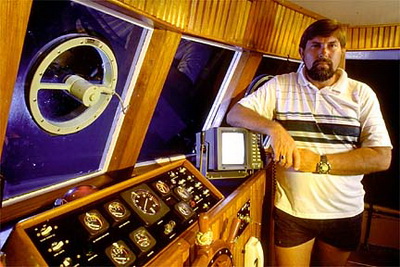
Tawali Dive Resort was the brainchild of Rob van der Loos, the owner of the Milne Bay based liveaboard MV Chertan.
Second only to Bob Halstead in pioneering Milne Bay diving, Rob literally knows the bay better than anybody. Having spent over 30 years diving every nook and cranny!
Rob and the Chertan enjoy a very strong reputation amongst underwater photographers. Particularly the ones who like to photograph critters.
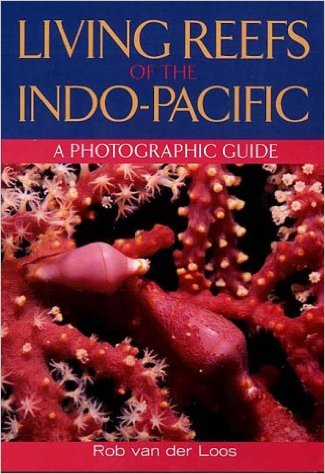
Because Rob not only knows where they are, he goes out of his way to get that special photo-opportunity for you. And his book the Living Reefs of the Indo-Pacific is a superb guide to critter habitats and how to find them.
Rob wanted to build an environmentally friendly resort on the outer north coast of Milne Bay. And enable day-diving on what are some of the very best sites such as Wahoo Point, Deacon’s Reef and Little China.
He took that concept and turned it into a reality with the help of his partners – Bob Hollis the founder and former CEO of US diving equipment company Oceanic. And the large Alotau based PNG company Nawae Construction.
Not an easy task when there were no roads, running water or power in the area and it took 8 years to just negotiate the lease on the tribal land that the resort is built on.
Physically the resort is located on a limestone headland at the northern side of the peninsular that forms the north coast of Milne Bay. On either side of the headland are sheltered bays, and the resort overlooks the smaller southern bay while the larger northern one is where the service area of the resort is located.
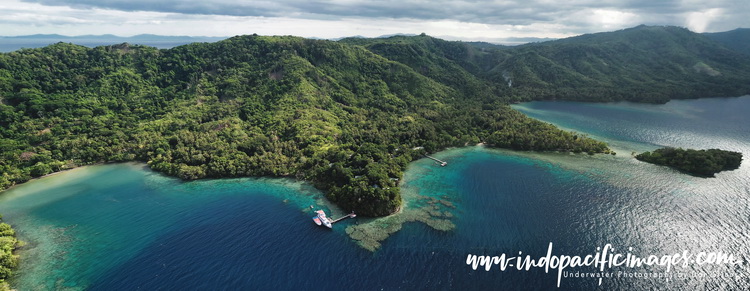
Arrival at the resort is via boat at the main jetty in the southern bay. And a short walk from the main jetty, up a wooden boardwalk, brings you to the entrance of the main lodge which hosts the main reception area, the restaurant, a small bar and the large observation deck overlooking the bay.
Covered walkways lead from the main lodge to the individual guest bungalows and then around the headland to the service area.
Simply stated, Tawali Dive Resort is impressive and well run. The guest bungalows are very nice and the restaurant produces excellent meals every time you go I there!
But it’s the diving on the north coast dive sites that most people visit Tawali for and a typical day starts at 08.00 from the main jetty. Most people dive three times a day and sample as many of those sites as possible. Returning mid-afternoon in time for either a night dive on the house reef and jetty or a sundowner on the excellent observation deck at the main lodge.
Download Milne Bay – Where it all Began article

